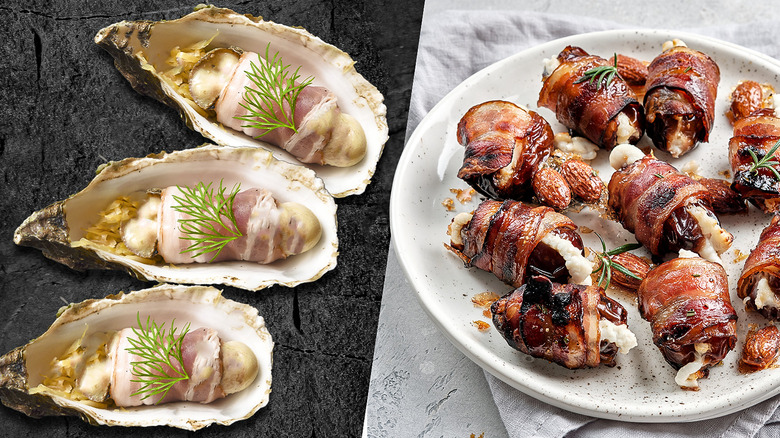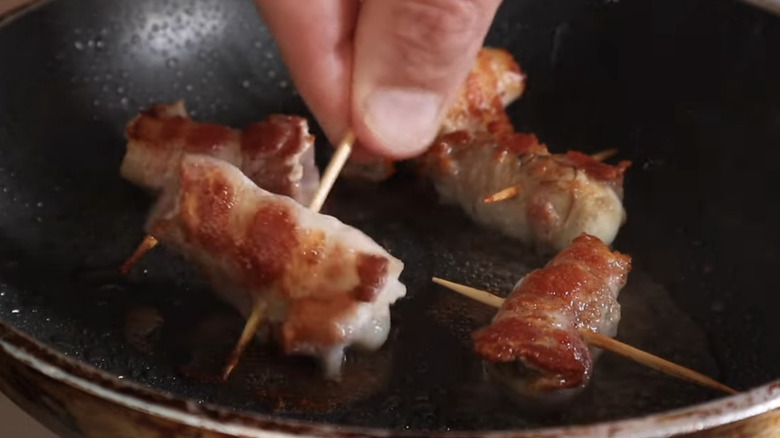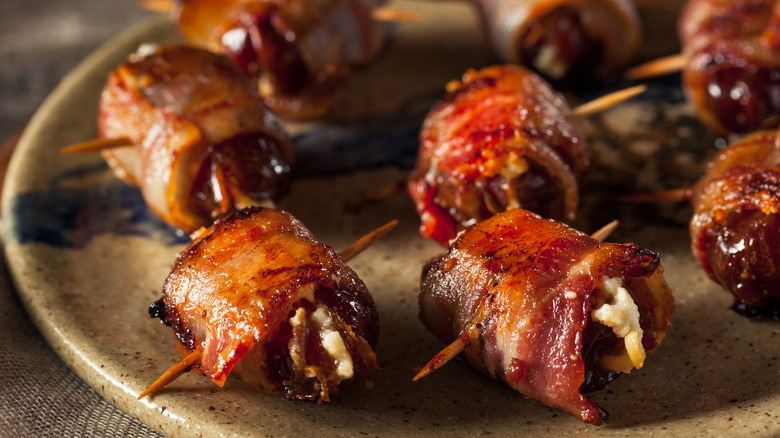Angels Vs Devils On Horseback: What's The Difference Between These Biblical Appetizers?
Although "angels on horseback" and "devils on horseback" may sound frighteningly serious in name, you may be surprised to learn that these are just two types of canapés. These snacks share a lot of similarities, even if you can't tell what they are by name alone; while their titles certainly relate them to one another, they're also thematic opposites.
Nowadays, both of these canapés are typically enjoyed as a passed appetizer or small plate. Historically, though, horseback snacks actually started as post-dessert savory bites, similar to how folks today might enjoy a cheese board. Additionally, both of these canapés are bacon-wrapped, and both originated in Victorian England. The major difference is what's stored in the center — the "angel" variety is bacon-wrapped oysters, whereas the "devil" version is bacon-wrapped dates or plums. Beyond this key difference, though, these bite-sized appetizers vary in several other ways, especially between recipes. Let's explore what makes these canapés unique.
The origins of angels on horseback
Both angels and devils on horseback began as 19th-century canapés, but of course, one had to come before the other. Though stories and records vary, it seems as though angels were the first to debut on England's dessert plates. The first written recipe for the bite-size food comes from a 19th-century cookbook, which refers to them as "les anges à cheval," the French translation of "angels on horseback." One theory about the name's origin connects it to the dish's oysters, which, when broiled as the recipe dictates, curl up at the edges, creating a feathery, wing-like effect. Some angels on horseback consist of nothing more than cooked, bacon-wrapped oysters and a bit of lemon juice; others are served on toasted bread with sauce, and still others are served in the oyster's shell.
For quite some time, you couldn't attend a dinner party without seeing a few of these bacon-wrapped delights. They remained popular throughout the mid-20th century and were even favored in America by prominent folks like the Kennedys. So, why did this dish suddenly disappear from menus and canapé trays? Likely because, due to over-harvesting, oysters became a very expensive sign of opulence rather than a common food.
The devil likely came after
Devils on horseback recipes swap out oysters for dried stone fruit, although these too have variations. In the U.S., most recipes call for dates, but back in England, prunes are the preferred base. These two dried fruits have similar but distinct flavors: Prunes, which are simply dried, pitted plums, offer a delicately sweet flavor with a fair bit of citrus-like acidity; dates, on the other hand, which are grown from date palms, are much more cloyingly sweet and sticky, with a center that's often compared to molasses or caramel. Bacon, thanks to its smoky, salty flavors, pairs beautifully with either of these. But that's not where the variation ends. One recipe may call for stuffing the date (or prune) with almonds, while others opt for a funky bleu cheese. Some recipes may even instruct you to soak the fruits in a brandy bath.
Devils on horseback seem to have gotten their name for a few reasons. Primarily, the dish shares the bacon cocoon of its predecessor, angels on horseback. But why the devil? One theory is that the contrast between red-streaked bacon and blackened fruit simply looked a bit spooky. Another is that devils on horseback were typically served piping hot, straight off the grill or from under the broiler.


